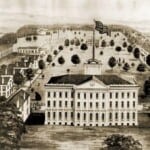
Introduction to the Model 1816 Musket
The Model 1816 musket was one of the most widely manufactured and utilized firearms in early American history, serving as the standard-issue infantry musket for the U.S. military for nearly three decades. Produced primarily at Springfield Armory and Harpers Ferry Armory, the Model 1816 saw extensive use from the 1820s through the early years of the American Civil War, undergoing significant modifications along the way. With over 675,000 units produced between 1816 and 1844, it was a cornerstone of U.S. military firepower, symbolizing the nation’s commitment to both firepower and evolving technological improvements in arms manufacture.
Development and Production
The Model 1816 was developed as an evolution of the Model 1795 musket, itself inspired by the French Charleville Model 1777. The shift toward standardized firearm production in the United States meant that the Model 1816 was designed to be interchangeable in parts, allowing for streamlined repairs and maintenance—a significant advancement at the time.
Production took place at both Springfield Armory (Massachusetts) and Harpers Ferry Armory (Virginia, now West Virginia), but private contractors also contributed, fulfilling military contracts as demand grew. Some of these included Asa Waters, D.C. Hodgkins, Lemuel Pomeroy, and Eli Whitney, who helped meet production quotas for various state militias and regular army needs.
Technical Specifications
- Caliber: .69
- Overall Length: 58 inches
- Barrel Length: 42 inches
- Weight: Approximately 9.8 lbs
- Ammunition: .69 caliber round ball with paper cartridge
- Powder Charge: ~110 grains of black powder
- Ignition System: Flintlock (later converted to percussion cap in many cases)
- Effective Range: 50–75 yards
The .69 caliber round ball was large and heavy, packing significant stopping power at close ranges. However, due to its smoothbore design, accuracy beyond 75 yards was poor, making mass volley fire tactics essential in battle.
Variants of the Model 1816
The Model 1816 musket evolved over time, with three primary variations produced:
Type I (1816–1822)
This early version retained characteristics of the preceding Model 1795, featuring a bright-finished barrel and a distinctive curved hammer. It was entirely flintlock-based, with no modifications for percussion systems.
Type II (1822–1831)
Sometimes referred to as the Model 1822, this variation introduced browned barrels (a protective finish to prevent rust) and other minor refinements in stock shape and lock plate markings.
Type III (1831–1844)
This final flintlock iteration incorporated slight improvements in manufacturing precision. It was largely indistinguishable from the Type II but refined in fit and finish, setting the stage for the adoption of the Model 1842, which became the first U.S. musket manufactured entirely with a percussion cap system.
Flintlock Ignition and Conversion to Percussion
The Model 1816 originally used a flintlock ignition system, in which a piece of flint struck a steel frizzen to produce sparks, igniting the black powder charge. This method, though reliable in trained hands, suffered from misfires and vulnerability to wet weather, necessitating its gradual replacement by the superior percussion cap system.
Percussion Conversions (1840s–1860s)
As military firearms technology progressed, thousands of Model 1816 muskets were converted to percussion ignition, significantly improving reliability in damp conditions. These conversions took several forms:
- Cone-in-barrel conversion – A simple modification in which the existing flintlock system was replaced with a percussion nipple screwed directly into the barrel.
- Belgian (Bolster) Conversion – A more extensive modification that added a bolster to the side of the barrel, making the musket stronger and more reliable under field conditions.
- Arsenal conversions – Conducted at Springfield Armory, Harpers Ferry, and various private workshops, these modifications ensured that Model 1816 muskets remained serviceable even after percussion muskets and rifles became the new standard.
By the time of the Mexican-American War (1846–1848), many Model 1816 muskets had been converted to percussion, and during the American Civil War, percussion-converted Model 1816s were issued primarily to state militias, Confederate forces, and second-line Union troops.
Service History and Combat Use
Mexican-American War (1846–1848)
The Model 1816, both in flintlock and percussion form, saw widespread use during the Mexican-American War. While many soldiers had access to newer percussion firearms, older muskets remained in frontline use, particularly in state militia units.
American Civil War (1861–1865)
At the outbreak of the Civil War, the Union and Confederate armies scrambled to equip their soldiers, leading to the widespread issuance of converted Model 1816 muskets to militias and reserve forces. The Confederate army, in particular, relied on a mix of older smoothbore muskets, including thousands of Model 1816s, due to severe weapon shortages.
While rifled muskets like the Model 1861 Springfield and the British Enfield Pattern 1853 eventually became dominant, the smoothbore Model 1816s remained in use, especially when loaded with “buck and ball” ammunition—a combination of a large round ball and smaller buckshot pellets that compensated for the smoothbore’s lack of accuracy.
Legacy of the Model 1816
The Model 1816 musket played a vital role in American military history, serving as the primary U.S. infantry weapon for over 25 years and continuing to see service in various capacities through the Civil War. Its production and modifications reflect the gradual transition from flintlock to percussion ignition, and its robust design ensured its longevity.
Additionally, the Model 1816’s influence extended into later designs. The Model 1842, which replaced it, was directly inspired by the 1816’s form but introduced the fully standardized percussion system. The gradual shift toward rifled barrels and smaller-caliber ammunition in the 1850s marked the end of the smoothbore musket era, but the lessons learned from the Model 1816 informed future U.S. military small arms development.
Conclusion
The Model 1816 musket is a defining piece of early 19th-century American military history. With hundreds of thousands produced, it was a symbol of a young and expanding nation, equipping generations of soldiers from the 1820s through the Civil War. Its adaptability—evolving from flintlock to percussion and from frontline to reserve use—demonstrates the ingenuity of American arms development in the era.
Whether in the hands of a U.S. infantryman on the fields of Mexico, a Confederate soldier in the early days of the Civil War, or a militia unit guarding home soil, the Model 1816 was a steadfast and enduring weapon. Its legacy, preserved in collections and museums today, stands as a tribute to the craftsmanship, durability, and historical significance of early American muskets.
These iconic rifles are still popular today. The image below is is Pedersoli reproduction of a Model 1816. Click to learn more or purchase.

Read more about the 1816 Musket here:
To join in on discussions about this and many other historical weapons, join the forums here.
If you know of any forums or sites that should be referenced on this listing, please let us know here.






